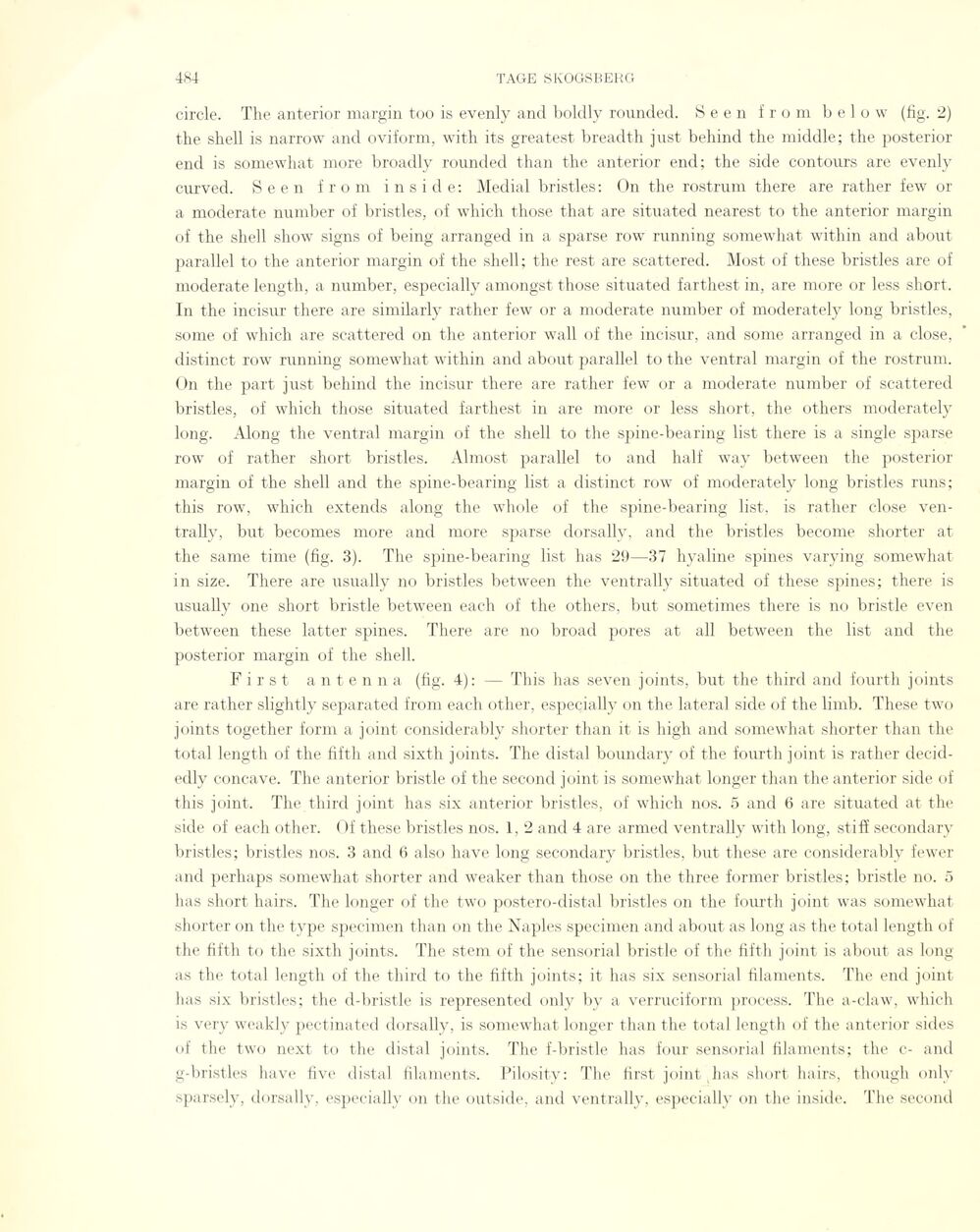
Full resolution (JPEG) - On this page / på denna sida - Sidor ...

<< prev. page << föreg. sida << >> nästa sida >> next page >>
Below is the raw OCR text
from the above scanned image.
Do you see an error? Proofread the page now!
Här nedan syns maskintolkade texten från faksimilbilden ovan.
Ser du något fel? Korrekturläs sidan nu!
This page has never been proofread. / Denna sida har aldrig korrekturlästs.
circle. The anterior margin too is evenly and boldly rounded. Seen from b e 1 o w (fig. 2)
the shell is narrow and oviform, with its greatest breadth just behind the middle; the posterior
end is somewhat more broadly rounded than the anterior end; the side contours are evenly
curved. Seen from inside: Medial bristles: On the rostrum there are rather few or
a moderate number of bristles, of which those that are situated nearest to the anterior margin
of the shell show signs of being arranged in a sparse row running somewhat within and about
parallel to the anterior margin of the shell; the rest are scattered. Most of these bristles are of
moderate length, a number, especially amongst those situated farthest in, are more or less short.
In the incisur there are similarly rather few or a moderate number of moderately long bristles,
some of which are scattered on the anterior wall of the incisur, and some arranged in a close,
distinct row running somewhat within and about parallel to the ventral margin of the rostrum.
On the part just behind the incisur there are rather few or a moderate number of scattered
bristles, of which those situated farthest in are more or less short, the others moderately
long. Along the ventral margin of the shell to the spine-bearing list there is a single sparse
row of rather short bristles. Almost parallel to and half way between the posterior
margin of the shell and the spine-bearing list a distinct row of moderately long bristles runs;
this row, which extends along the whole of the spine-bearing list, is rather close
ven-trally, but becomes more and more sparse dorsally, and the bristles become shorter at
the same time (fig. 3). The spine-bearing list has 29—37 hyaline spines varying somewhat
in size. There are usually no bristles between the ven trally situated of these spines; there is
usually one short bristle between each of the others, but sometimes there is no bristle even
between these latter spines. There are no broad pores at all between the list and the
posterior margin of the shell.
First antenna (fig. 4): — This has seven joints, but the third and fourth joints
are rather slightly separated from each other, especially on the lateral side of the limb. These two
joints together form a joint considerably shorter than it is high and somewhat shorter than the
total length of the fifth and sixth joints. The distal boundary of the fourth joint is rather
decid-edly concave. The anterior bristle of the second joint is somewhat longer than the anterior side of
this joint. The third joint has six anterior bristles, of which nos. 5 and 6 are situated at the
side of each other. Of these bristles nos. 1, 2 and 4 are armed ventrally with long, stifï secondary
bristles; bristles nos. 3 and 6 also have long secondary bristles, but these are considerably fe wer
and perhaps somewhat shorter and weaker than those on the three former bristles; bristle no. 5
has short hairs. The longer of the two postero-distal bristles on the fourth joint was somewhat
shorter on the type specimen than on the Naples specimen and about as long as the total length of
the fifth to the sixth joints. The stem of the sensorial bristle of the fifth joint is about as long
as the total length of the third to the fifth joints; it has six sensorial filaments. The end joint
has six bristles; the d-bristle is represented only by a verruciform process. The a-claw, which
is very weakly pectinatecl dorsally, is somewhat longer than the total length of the anterior sides
of the two next to the distal joints. The f-bristle has four sensorial filaments; the c- and
g-bristles have five distal filaments. Pilosity: The first joint has short hairs, thougli only
sparsely, dorsally, especially on the outside, and ventrally, especially on the inside. The second
<< prev. page << föreg. sida << >> nästa sida >> next page >>